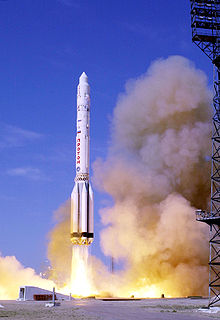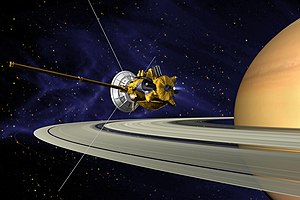Spacecraft
A spacecraft is a vessel, craft or device designed to operate beyond the surface of the Earth in outer space. Spacecraft may either be unmanned or manned. Spacecraft are designed for a variety of missions which may include communications, earth observation, meteorology, navigation, planetary exploration, space tourism and space warfare. The term spacecraft is also used to describe artificial satellites. Spacecraft also feature in works of science fiction.

Overview
A spacecraft system comprises various subsystems, dependent upon mission profile. Spacecraft subsystems may include: attitude determination and control (variously called ADAC, ADC or ACS), guidance, navigation, and control (GNC or GN&C), communications (COMS), command and data handling (CDH or C&DH), power (EPS), thermal control (TCS), propulsion, structures, and payload. Manned spacecraft have the additional requirement of providing life support to the crew.
Spacecraft subsystems
Attitude control
Spacecraft need an attitude control subsystem in order that they may be correctly oriented in space and respond to external torques and forces properly. The attitude control subsystem consists of sensors and actuators, together with controlling algorithms. The attitude control subsystem permits proper pointing for the science objective, sun pointing for power to the solar arrays and earth-pointing for communications.
GNC
Guidance refers to the calculation of the commands (usually done by the CDH subsystem) needed to steer the spacecraft where it is desired to be. Navigation means determining a spacecraft's orbital elements or position. Control means adjusting the path of the spacecraft to meet mission requirements. On some missions, GNC and Attitude Control are combined into one subsystem of the spacecraft.
Command and data handling
The CDH subsystem receives commands from the communications subsystem, performs validation and decoding of the commands, and distributes the commands to the appropriate spacecraft subsystems and components. The CDH also receives housekeeping data and science data from the other spacecraft subsystems and components, and packages the data for storage on a solid state recorder or transmission to the ground via the communications subsystem. Other function of the CDH include maintaining the spacecraft clock and state-of-health monitoring.
Power
Spacecraft need an electrical power generation and distribution subsystem for powering the various spacecraft subsystems. For spacecraft near the Sun, solar panels are frequently used to generate electrical power. Spacecraft designed to operate in more distant locations, for example Jupiter, might employ a Radioisotope Thermoelectric Generator (RTG) to generate electrical power. Electrical power is sent through power conditioning equipment before it passes through a power distribution unit over an electrical bus to other spacecraft components. Batteries are typically connected to the bus via a battery charge regulator, and the batteries are used to provide electrical power during periods when primary power is not available, for example when a Low Earth Orbit (LEO) spacecraft is eclipsed by the Earth.
Thermal control
Spacecraft must be engineered to withstand transit through the Earth's atmosphere and the space environment. They must operate in a vacuum with temperatures potentially ranging across hundreds of degrees Celsius. Depending on mission profile, spacecraft may also need to operate on the surface of another planetary body. The thermal control subsystem can be passive, dependent on the selection of materials with specific radiative properties. Active thermal control makes use of electrical heaters and certain actuators such as louvres to control temperature ranges of equipments within specific ranges.
Propulsion
Spacecraft may or may not have a propulsion subsystem, depending upon whether or not the mission profile calls for propulsion. The Swift spacecraft is an example of a spacecraft that does not have a propulsion subsystem. Typically though, LEO spacecraft (for example Terra (EOS AM-1) include a propulsion subsystem for altitude adjustments (called drag make-up maneuvers) and inclination adjustment maneuvers. A propulsion system is also needed for spacecraft that perform momentum management maneuvers. Components of a conventional propulsion subsystem include fuel, tankage, valves, pipes, and thrusters. The TCS interfaces with the propulsion subsystem by monitoring the temperature of those components, and by preheating tanks and thrusters in preparation for a spacecraft maneuver.

Structures
Spacecraft must be engineered to withstand launch loads imparted by the launch vehicle, and must have a point of attachment for all the other subsystems. Depending upon mission profile, the structural subsystem might need to withstand loads imparted by entry into the atmosphere of another planetary body, and landing on the surface of another planetary body.
Payload
The payload is dependent upon the mission of the spacecraft, and is typically regarded as the part of the spacecraft "that pays the bills". Typical payloads could include scientific instruments (cameras, telescopes, or particle detectors, for example), cargo, or a human crew.
Ground system
The ground system, though not technically part of the spacecraft, is vital to the operation of the spacecraft. Typical components of a ground system in use during normal operations include a mission operations facility where the flight operations team conducts the operations of the spacecraft, a data processing and storage facility, ground stations to radiate signals to and receive signals from the spacecraft, and a voice and data communications network to connect all mission elements.
Launch vehicle
The launch vehicle is used to propel the spacecraft from the Earth's surface, through the atmosphere, and into an orbit, the exact orbit being dependent upon mission configuration. The launch vehicle may be expendable or reusable.
Fictional spacecraft
The term spacecraft is mainly used to refer to spacecraft that are real or conceived using present technology. The terms spaceship and starship are generally applied only to fictional spacecraft, usually those capable of transporting people. The spaceship is one of the prime elements in science fiction. Numerous short stories and novels are built up around various ideas for spacecraft, and spacecraft have often been featured in movies. Some hard science fiction books focus on the technical details of the craft, while others treat the spacecraft as a given and delve little into its actual implementation.
Some famous fictional spacecraft
(see List of fictional spaceships)
- USS Enterprise and Klingon Bird of Prey from Star Trek
- Millennium Falcon, Death Star, X-Wing and Tie fighter from Star Wars
- The TARDIS from the British science fiction TV series Doctor Who.
- Discovery One from 2001: A Space Odyssey
- The Battlestar Galactica from the various TV series of the same name.
- Daedalus class battlecruiser from Stargate Atlantis
Unidentified flying objects
Some people believe that Unidentified Flying Objects (UFOs) may be alien spacecraft (that is, not of human construction and not originating from Earth), sometimes referred to as flying saucers. But the term UFO used here in this context refers to observed flying objects for which no identification has been made, though other meanings for the word UFO exist. To date, no known, independently verifiable examples of alien spacecraft are known to exist.
Examples of spacecraft
Manned spacecraft

- Apollo Spacecraft
- Gemini Spacecraft
- International Space Station
- Mir
- Mercury Spacecraft
- Shuttle Buran
- Shenzhou Spacecraft
- Space Shuttle
- Soyuz Spacecraft
- SpaceShipOne
- Voskhod Spacecraft
- Vostok Spacecraft
Heaviest spacecraft
- NASA STS Space Shuttle/Orbiter - 109,000 kg or 120 tons (US).


Unmanned spacecraft
- Cassini-Huygens
- Cluster
- Deep Space 1
- Deep Impact (space mission)
- ESA SMART-1 Lunar Impact
- Galileo
- Genesis
- Lunar Prospector
- Mars Exploration Rover
- Mars Global Surveyor
- Mars Pathfinder
- Near Earth Asteroid Rendezvous
- New Horizons
- Soviet Buran (one mission only)
- Pioneer 10
- Pioneer 11
- Progress
- SOHO
- Stardust
- Surveyor
- WMAP
Fastest spacecraft
- Helios I & II Solar Probes (252,792 km/h).

Furthest spacecraft from Earth
- Voyager 1 at 9582.4234 billion miles.
- Pioneer 10 at 8344.5237 billion miles.
- Voyager 2 at 7435.1695 billion miles.
Spacecraft under development
- Automated Transfer Vehicle (ATV)
- Orion spacecraft
- Kliper - Russian ' Clipper '
- H-II Transfer Vehicle
- India Chandrayan-1 lunar probe
- CNES Mars Netlander
- James Webb Space Telescope (delayed)
- Kepler Mission Planet Searcher
- ESA Darwin probe
- NASA Dawn Mission probe
- Herschel Space Observatory
- Mars Science Laboratory rover
- Phoenix Mars Scout
- Shenzhou Cargo
- Terrestrial Planet Finder probe
Commercial spacecraft
- Genesis-1 inflated orbiting habitat (manned).
Commercial spacecraft under development
- Bristol Ascender space plane
- Rocketplane XP
- Skylon SSTO
- Space Adventures Explorer rocket plane
- Space Dev Dream Chaser
- Space Ship Two
- SpaceX Dragon capsule
- Virgin Galactic
Cancelled spacecraft programs
- Chinese Project 921-3 Shuttle
- ESA Hermes Shuttle
- Soviet Buran Shuttle
- Soyuz Kontakt
Cancelled SSTO spacecraft
- RR/British Aerospace HOTOL
- ESA Hopper Orbiter
- McDonnell Douglas DC-X (Delta Clipper)
- Roton Rotored-Hybrid
- Lockheed-Martin VentureStar
See also
- Portal:Spaceflight
- List of spaceflights
- Spacecraft design
- Starship
- Ansari X Prize
- Atmospheric reentry
References
Wertz, James (1999). Space Mission Analysis and Design, ISBN 978-1881883104 (Third Edition ed.). Torrance, CA: Microcosm, Inc. {{cite book}}: |edition= has extra text (help); Unknown parameter |coauthors= ignored (|author= suggested) (help)
